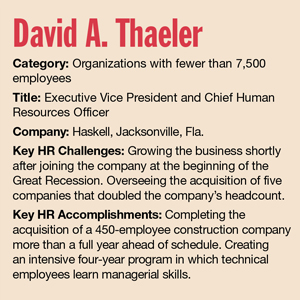This article accompanies Investing in the Future.
Global financial markets were tipping into turmoil and David A. Thaeler’s new employer was facing a similar fate when he joined Haskell as its senior vice president of HR in late 2008.
“The Great Recession hit our business and industry with full force almost immediately upon David’s arrival,” says Steven T. Halverson, the chairman, president and CEO of the Jacksonville, Fla.-based architecture, engineering and construction firm. “Within months, our business declined by almost 35 percent.”
Lesser executives may have chosen to go into a circle-the-wagons mode when presented with such a scenario. But Thaeler, who holds dual master degrees in labor and human resources and public policy from Ohio State University, decided on another approach.
“Dave saw the crisis as an opportunity,” Halverson says. “He counseled me not to delay my plans for cultural transformation, but rather to use the crisis as an opportunity to build and reinforce our commitment to our core values and our people.”
Since then, Thaeler has taken on the title of Haskell’s executive vice president and chief human resources officer as the company expanded through a series of acquisitions from three offices to 20 worldwide. It also nearly doubled its headcount – to 1,500 employees – and now boasts approximately $850 million in annual revenue.
But back in early 2009, one of Thaeler’s first moves after arriving was to implement a company-wide communications plan with monthly updates about the state of the economy and organization. The monthly messages shared real-time status updates that offered transparent views of corporate operations.
During that difficult period, Thaeler says, “people didn’t know what was going on. We wanted to make sure employees knew what was happening in our industry, where there were challenges and where there was growth in different markets that we were attacking as an organization.”
If any of the projects were having issues, he says, “we wanted to make sure our team knew what they were and what our plans were to correct them.”
Meanwhile, an employee survey conducted in March 2009 revealed room for improvement in the company’s management training program, especially for individuals who may have moved from technical roles to management positions.
Working with a third party, Thaeler’s HR team created its Leadership Series, an intensive four-year program in which technical employees – such as engineers, architects and construction professionals – are nominated by their supervisors to participate in developing managerial skills. Roughly 100 employees have so far participated in the program. Many of the graduates have since been promoted to higher roles within the company.
One of the goals of the program is to give participants a sense of what it’s like to be a Haskell manager, Thaeler adds.
As a result of learning initiatives such as the Leadership Series, Haskell has been named by Training magazine a Top 125 learning organization for the past five years.
At the same time the company was addressing the issue of leadership development, Thaeler says, it was also was in the process of growing its headcount through acquisitions. In 2010, the company successfully acquired and integrated four companies – and their 258 employees – with geographies and services that fit its business strategy. Then, in April 2016, it made its largest acquisition yet – Benham, a construction and engineering firm with five offices and almost 450 employees.
That acquisition was expected to take two years to complete, but under Thaeler – who gained experience in mergers and acquisitions at his previous employers – the process was completed in early 2017, more than a full year ahead of schedule.
Thaeler is quick to deflect credit for the company’s success in acquisitions.
“A lot of it has to do with leadership and aligned values,” Thaeler says. Because Benham’s leadership team was similarly aligned with Haskel’s values, he adds, the acquisition was able to move forward quickly and smoothly.
At the same time, Thaeler continues, the entire HR team – including employee relations, benefits, technology and recruiting – worked together to make sure they were focused on what really needed to be done “instead of getting distracted like a lot of organizations do with integration efforts.”
Reflecting on Thaeler’s many achievements, Halverson says it would be impossible to overstate his importance to the organization. (In addition to holding a seat on the company’s board of directors, Thaeler also serves as one of the four members of the company’s office of the chief executive.)
Thaeler is hardly your average HR leader, Halverson says. “He is a strategist; he is a cultural leader; he is a confidante; he is a friend,” he explains. “A very large part of the credit for the extraordinary transformation of Haskell – culturally, strategically and operationally – goes to Dave. He has made me a better CEO.”

